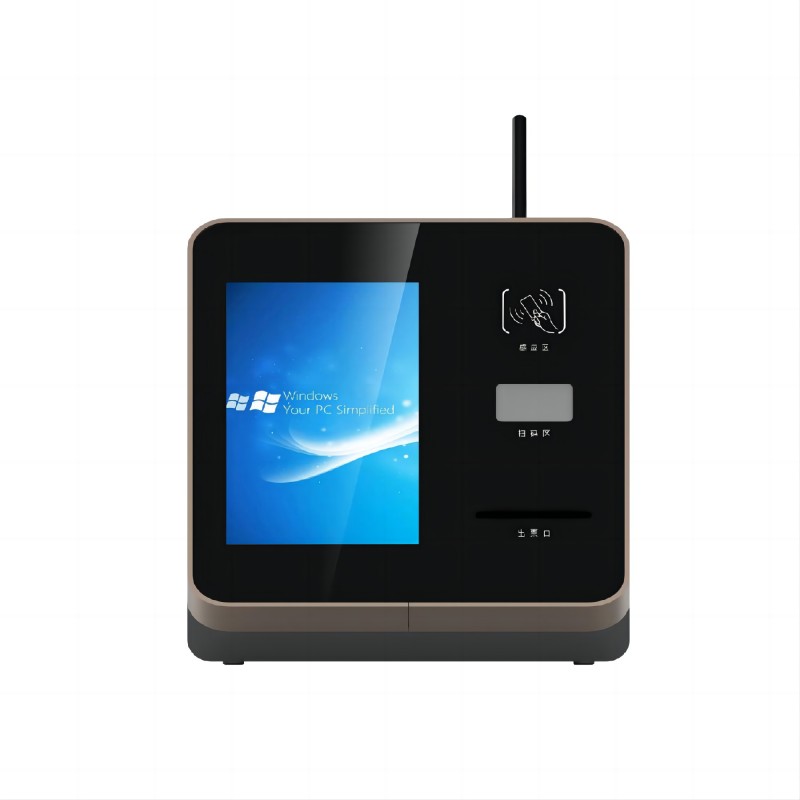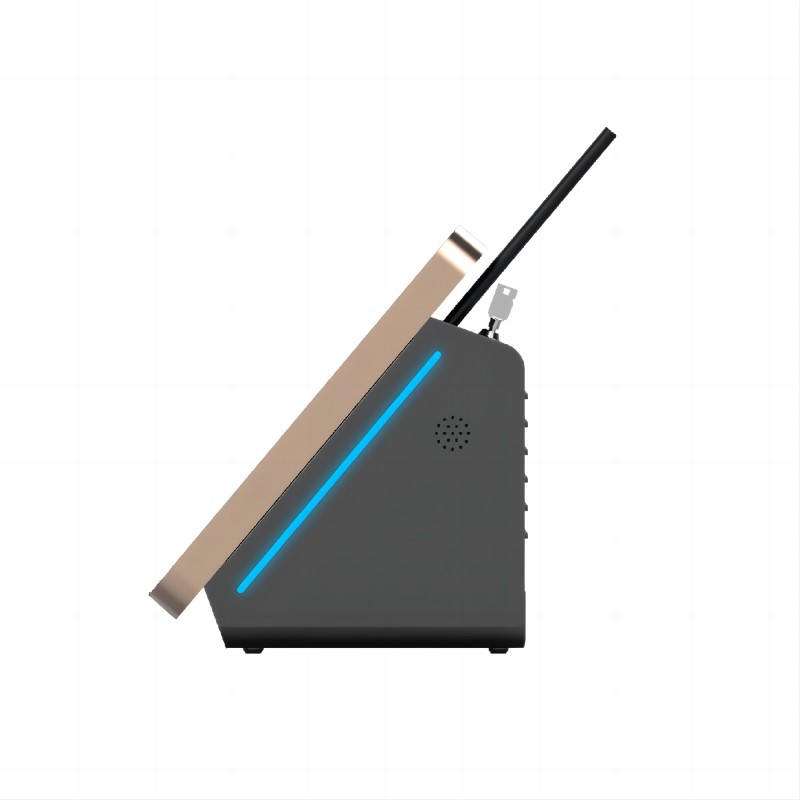
| Component | Specification 1 | Specification 2 | Specification 3 | Specification 4 |
|---|---|---|---|---|
| Touchscreen Display | Size: 15" to 32" | Resolution: Full HD (1920x1080) or higher | Type: Capacitive or resistive | Multi-touch capabilities |
| Processor | Type: Intel, ARM | Speed: 1.6 GHz to 3.0 GHz | Cores: Dual-core or quad-core | Handles POS software and transactions |
| Operating System | Options: Windows, Android, Linux | Customizable based on requirements | Supports POS software | - |
| Memory (RAM) | Capacity: 4GB to 8GB | Expandable | Supports smooth operation of POS applications | - |
| Storage | Type: SSD | Capacity: 64GB to 256GB | Expandable if needed | - |
| Payment Modules | Card Reader: EMV-compliant chip and mag stripe | Contactless Payment: NFC | Cash Acceptor/Dispenser: Optional | Receipt Printer: Thermal printer |
| Connectivity | Wi-Fi: 802.11 a/b/g/n/ac | Ethernet: RJ45 for wired connections | Bluetooth: For peripherals | - |
| Security Features | Encryption: For secure payment transactions | Tamper Detection: For unauthorized access | Encrypted PIN Pad: For secure card transactions | Optional Camera: For security or verification |
| Enclosure | Material: Durable steel or aluminum | Design: Vandal-resistant, robust | Mounting: Floor-standing or countertop | - |
| Additional Peripherals | Barcode Scanner: For product scanning | Speaker: For audio feedback | Cash Drawer: For cash transactions | Optional: Customer display |
| Power Supply | Voltage: 110-240V AC | Backup: Uninterruptible Power Supply (UPS) | - | - |
| Environment | Temperature Range: 0°C to 40°C | Humidity: 10% to 90% non-condensing | Designed for indoor use | - |
| Certifications | Compliance: CE, FCC, RoHS, PCI-DSS | - | - | - |
Design and Prototyping: The process begins with designing the kiosk based on customer requirements and industry standards. Engineers create detailed design specifications and prototypes, including the kiosk’s hardware and software components, to ensure functionality and usability.
Component Sourcing: Essential components such as touchscreens, processors, payment modules (card readers, NFC), printers, and enclosures are sourced from suppliers. Quality control measures are implemented to ensure these components meet required standards and specifications.
Assembly: The kiosk is assembled by integrating various components. This includes installing the touchscreen display, processor, memory, storage, and payment modules into the kiosk enclosure. Assembly also involves wiring and connecting the components to ensure proper functionality.
Software Installation: The operating system (e.g., Windows, Android) and POS software are installed and configured. This includes setting up the user interface, payment processing systems, and any additional applications required for the kiosk’s operation.
Testing and Quality Assurance: The assembled kiosks undergo rigorous testing to ensure all components function correctly. This includes hardware tests (e.g., touchscreen responsiveness, printer operation) and software tests (e.g., payment processing, system stability). Any issues found are addressed and corrected.
Deployment and Support: Once testing is complete, the kiosks are packaged and prepared for deployment. Installation teams set up the kiosks at their designated locations, and ongoing support is provided to address any issues that may arise after installation. This includes maintenance, software updates, and customer support.

Approach the Kiosk: Walk up to the POS kiosk and locate the touchscreen interface. Ensure the kiosk is powered on and operational.
Select Items or Services: Use the touchscreen to browse through the menu or list of available products and services. Tap on the items you wish to purchase or services you need.
Review Your Selection: After selecting items, review your choices on the screen. Make any necessary adjustments, such as changing quantities or removing items, before proceeding to payment.
Choose Payment Method: Select your preferred payment method from the available options, which may include credit/debit cards, mobile payments (NFC), or cash (if the kiosk supports it).
Complete Payment: Follow the on-screen instructions to complete the payment. For card payments, insert or swipe your card and enter your PIN if required. For mobile payments, use your phone to tap the NFC reader. If paying with cash, insert the money into the cash acceptor.
Print Receipt and Collect Items: Once the payment is processed, a receipt may be printed automatically. Collect the receipt and any purchased items from the kiosk, if applicable. If there are no physical items, you may receive a digital confirmation or ticket on the screen.

Retail Checkout: POS kiosks streamline the checkout process in retail stores, allowing customers to scan items, apply discounts or coupons, and make payments independently, reducing wait times and improving customer experience.
Quick-Service Restaurants: In fast food or quick-service restaurants, POS kiosks enable customers to place orders, customize their meals, and pay directly at the kiosk, speeding up service and reducing the need for counter staff.
Ticketing and Reservations: POS kiosks are used in cinemas, theaters, and transportation hubs for purchasing tickets and making reservations. Customers can select seats, choose showtimes, and pay for tickets without assistance.
Hospitality Industry: Hotels and resorts use POS kiosks for self-check-in, room selection, and payment of services like spa treatments or dining. This enhances the guest experience by offering quick and easy access to services.
Healthcare Facilities: In hospitals and clinics, POS kiosks handle patient check-ins, bill payments, and appointment scheduling. They help reduce administrative workloads and improve patient flow.
Retail Banking: POS kiosks in banks allow customers to perform basic banking tasks such as bill payments, account inquiries, and fund transfers. They reduce the need for teller interaction, offering a more efficient banking experience.
Event Management: At events or conferences, POS kiosks facilitate on-site registration, badge printing, and payment for entry or merchandise. This helps manage large crowds and speeds up the check-in process.

The cost of a POS kiosk can vary widely depending on its features, specifications, and customization options. Here’s a general overview of the cost range and factors that affect the price:
Basic POS Kiosk: $1,500 - $3,000
Includes a touchscreen display, basic processor, and standard POS software.
Suitable for simple retail or restaurant applications.
Mid-Range POS Kiosk: $3,000 - $5,000
Features include a larger touchscreen, more advanced payment modules (e.g., EMV-compliant card readers, NFC), and additional peripherals like barcode scanners.
Ideal for higher-traffic retail environments or quick-service restaurants.
High-End POS Kiosk: $5,000 - $10,000+
Includes high-resolution touchscreens, powerful processors, extensive customization options, and advanced security features.
Often used in complex environments such as large retail stores, hotels, or multi-location businesses.
Hardware Specifications: Higher-quality touchscreens, processors, and additional peripherals will increase the cost.
Customization: Custom enclosures, branding, and additional features like integrated cameras or specialized printers can raise the price.
Software: The cost of POS software licenses, ongoing support, and updates can affect the total cost.
Payment Modules: Advanced payment options (e.g., contactless payment) and cash handling components contribute to the cost.
Installation and Support: Installation fees and ongoing maintenance or support contracts can add to the overall expense.
Assess Your Needs: Determine the specific requirements for your business, including the type of transactions, volume of use, and additional features needed.
Evaluate Features: Compare the features of different POS kiosks, including screen size, payment options, and peripheral support, to ensure they meet your business needs.
Consider Total Cost of Ownership: Factor in not just the initial purchase price, but also the costs of software licenses, maintenance, and potential upgrades.
Choose a Reliable Vendor: Select a reputable manufacturer or supplier known for quality products and good customer support. Read reviews and ask for references if needed.
Check for Scalability: Ensure that the POS kiosk can be easily upgraded or integrated with other systems as your business grows or changes.
Verify Warranty and Support: Confirm the warranty period and support options provided by the manufacturer to address any issues that may arise after purchase.
What did our happy clients say?
We're thrilled with our new POS kiosk! It’s user-friendly and streamlined our checkout process. A huge thanks to the manufacturer for delivering such a reliable and efficient solution.
The POS kiosk has exceeded our expectations! The quality and performance are top-notch. Thanks to the manufacturer for their excellent product and outstanding customer support.
We are very satisfied with the POS kiosk we purchased. It’s perfect for our needs and works flawlessly. Thanks to the manufacturer for providing such a high-quality and dependable product!
Our new POS kiosk is fantastic! It’s easy to use and has greatly improved our operations. A big thank you to the manufacturer for their excellent work and exceptional service!